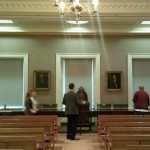
RTI & the decorated stela of Montoro
This decorated stela was found some years ago nearby the town of Montoro, in the Middle Guadalquivir Valley (Córdoba, South Spain). In September, David Wheatley (University of Southampton), Leonardo García Sanjuán (University of Seville) and I have conducted fieldwork to inspect the place where it was found and we have also applied enhanced techniques to record the stela, that is, RTI and laser scanning.
Continue reading →






